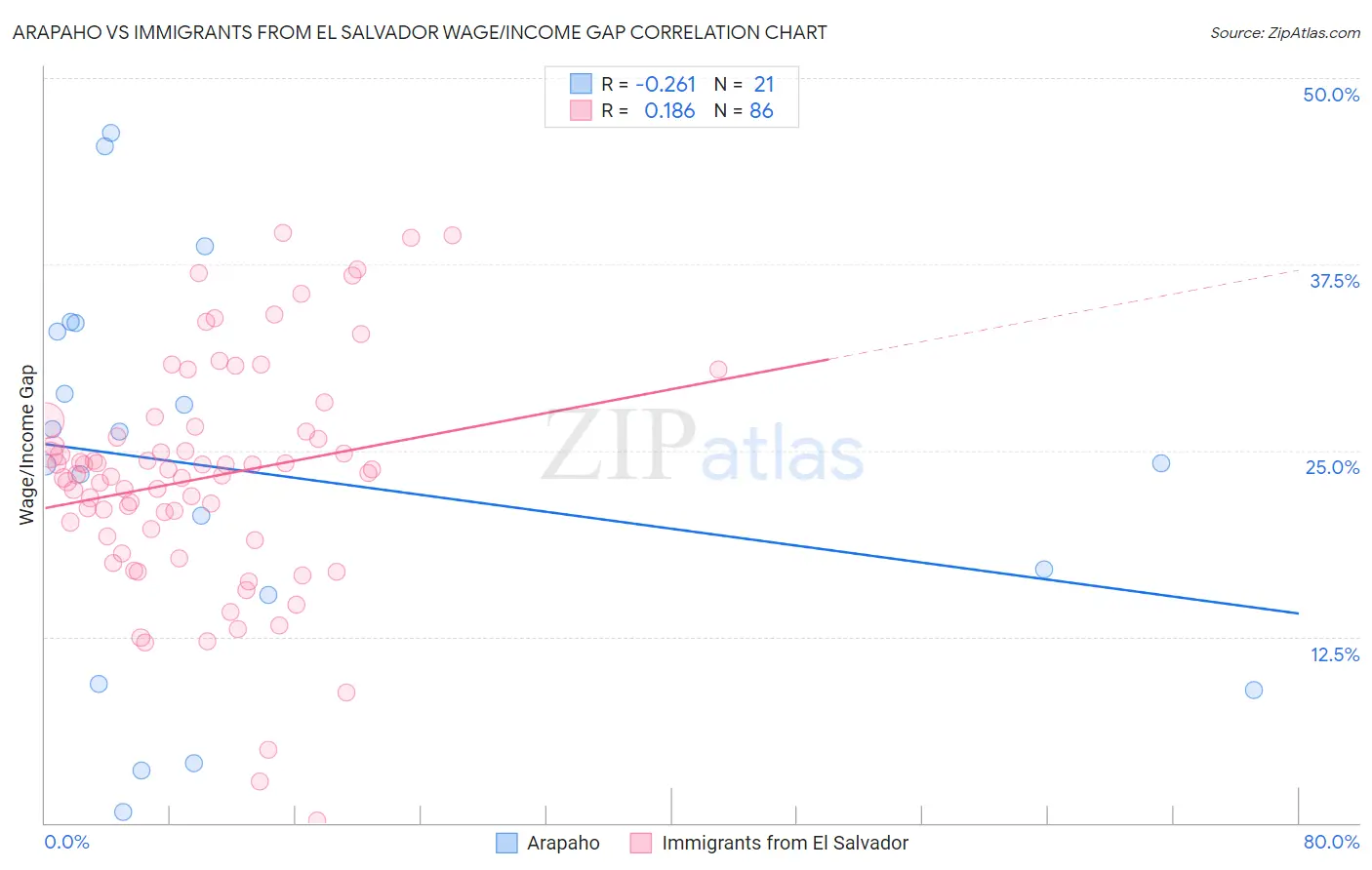Arapaho vs Immigrants from El Salvador Wage/Income Gap
COMPARE
Arapaho
Immigrants from El Salvador
Wage/Income Gap
Wage/Income Gap Comparison
Arapaho
Immigrants from El Salvador
23.5%
WAGE/INCOME GAP
99.6/ 100
METRIC RATING
91st/ 347
METRIC RANK
22.8%
WAGE/INCOME GAP
99.9/ 100
METRIC RATING
71st/ 347
METRIC RANK
Arapaho vs Immigrants from El Salvador Wage/Income Gap Correlation Chart
The statistical analysis conducted on geographies consisting of 29,769,339 people shows a weak negative correlation between the proportion of Arapaho and wage/income gap percentage in the United States with a correlation coefficient (R) of -0.261 and weighted average of 23.5%. Similarly, the statistical analysis conducted on geographies consisting of 357,610,247 people shows a poor positive correlation between the proportion of Immigrants from El Salvador and wage/income gap percentage in the United States with a correlation coefficient (R) of 0.186 and weighted average of 22.8%, a difference of 3.0%.

Wage/Income Gap Correlation Summary
| Measurement | Arapaho | Immigrants from El Salvador |
| Minimum | 0.71% | 0.18% |
| Maximum | 46.3% | 39.6% |
| Range | 45.6% | 39.4% |
| Mean | 23.4% | 23.2% |
| Median | 24.1% | 23.4% |
| Interquartile 25% (IQ1) | 12.3% | 19.2% |
| Interquartile 75% (IQ3) | 33.3% | 26.3% |
| Interquartile Range (IQR) | 20.9% | 7.1% |
| Standard Deviation (Sample) | 13.1% | 7.7% |
| Standard Deviation (Population) | 12.8% | 7.7% |
Demographics Similar to Arapaho and Immigrants from El Salvador by Wage/Income Gap
In terms of wage/income gap, the demographic groups most similar to Arapaho are Nicaraguan (23.4%, a difference of 0.14%), Marshallese (23.4%, a difference of 0.15%), Immigrants from Panama (23.4%, a difference of 0.24%), Yuman (23.3%, a difference of 0.56%), and Cheyenne (23.3%, a difference of 0.61%). Similarly, the demographic groups most similar to Immigrants from El Salvador are Subsaharan African (22.8%, a difference of 0.15%), Immigrants from Eastern Africa (22.8%, a difference of 0.18%), Immigrants from Burma/Myanmar (22.8%, a difference of 0.26%), Fijian (22.9%, a difference of 0.54%), and Ecuadorian (22.9%, a difference of 0.55%).
| Demographics | Rating | Rank | Wage/Income Gap |
| Immigrants | El Salvador | 99.9 /100 | #71 | Exceptional 22.8% |
| Sub-Saharan Africans | 99.9 /100 | #72 | Exceptional 22.8% |
| Immigrants | Eastern Africa | 99.9 /100 | #73 | Exceptional 22.8% |
| Immigrants | Burma/Myanmar | 99.9 /100 | #74 | Exceptional 22.8% |
| Fijians | 99.9 /100 | #75 | Exceptional 22.9% |
| Ecuadorians | 99.9 /100 | #76 | Exceptional 22.9% |
| Africans | 99.9 /100 | #77 | Exceptional 22.9% |
| Nigerians | 99.9 /100 | #78 | Exceptional 23.0% |
| Immigrants | Nicaragua | 99.9 /100 | #79 | Exceptional 23.0% |
| Salvadorans | 99.9 /100 | #80 | Exceptional 23.0% |
| Bermudans | 99.8 /100 | #81 | Exceptional 23.1% |
| Central Americans | 99.8 /100 | #82 | Exceptional 23.1% |
| Immigrants | Africa | 99.8 /100 | #83 | Exceptional 23.2% |
| Cubans | 99.7 /100 | #84 | Exceptional 23.3% |
| Immigrants | Cambodia | 99.7 /100 | #85 | Exceptional 23.3% |
| Cheyenne | 99.7 /100 | #86 | Exceptional 23.3% |
| Yuman | 99.7 /100 | #87 | Exceptional 23.3% |
| Immigrants | Panama | 99.6 /100 | #88 | Exceptional 23.4% |
| Marshallese | 99.6 /100 | #89 | Exceptional 23.4% |
| Nicaraguans | 99.6 /100 | #90 | Exceptional 23.4% |
| Arapaho | 99.6 /100 | #91 | Exceptional 23.5% |